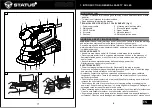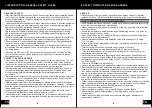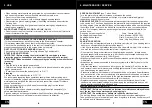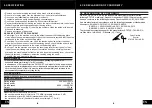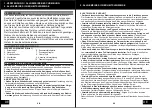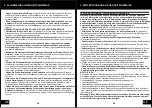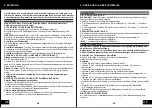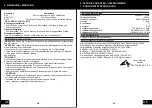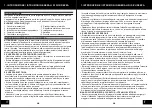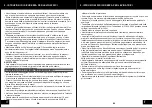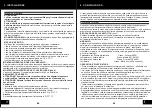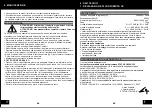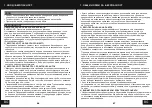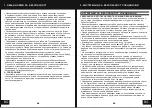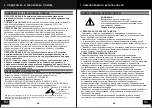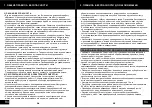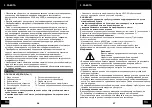
7
ASSEMBLY / ADJUSTMENT OF THE ABRASIVE SUPPORT
If it is not assembled yet, install it according to the “Maintenance” chapter.
If it is already assembled, check that it is taut without any folds.
Check that it is positioned exactly in the centre of the plate (pos.6) and that any holes
present correspond exactly to the suction holes on the plate.
DUST COLLECTION BOX ASSEMBLY (pos.5)
The coupling is of the pressure. Carefully observe fig.2 and install it.
STARTING AND STOPPING
IMPORTANT!
Before starting the electrical tool it is compulsory to wear
protection goggles, headphones and a dust repelling mask (not provided).
IMPORTANT! Make sure nobody is approaching the working area while the tool
is running.
Starting
•
Plug the tool into the electric power supply.
•
Grip the main handle firmly (pos.2); for models with a double handle, also grip the
upper handle (pos.8).
•
To start up move the switch button (pos.3) to “ON” “I”.
Stopping
•
To stop move the switch button to “OFF” “O”.
We recommend repeating these operations several times before starting work,
in order to familiarise yourself with the controls as far as possible. If you notice any
working defects, switch off the electrical tool and consult the chapter “Problems,
causes and solutions”.
When not using the tool, turn it off and disconnect the plug from the socket.
OPERATIONAL TIPS
After reading the previous chapters carefully, apply these tips scrupulously to
obtain maximum performance.
Proceed calmly so as to become familiar with all the controls; after having gained
sufficient experience you will be able to make full use of its potential.
SPEED ADJUSTMENT
(pos.7, when fitted)
Turn the grain roller in order to increase or decrease the speed.
The speed is to be adjusted based on the type of process, material and grain of
the abrasive support; do some tests.
ABRASIVE SUPPORT
Use the suitable abrasive support for the sanding operation
to be carried out. The choice depends on the material to be processed and the required
finishing degree; there are different types on the market marked with a number defining
the surface “grain”, printed on the back. Ask your retailer to give you the best advice
on this. Our company produces a wide range of abrasive supports suitable for the
various uses.
Roughing out with rough finish Grain - Coarse (40- 60)
Sanding with medium finish Grain - Medium (80-100-120)
Sanding with fine finish Grain - Fine (from 150 to 400)
Polishing Grain - Very fine (600 and over)
SANDING OPERATION
•
Before working on important objects (e.g. furniture, vehicles, etc.) do a sanding test to
ensure you have installed the right abrasive support.
•
If the item is small and light always fasten it with a vice while working; if it is not faste-
ned well, the action of the machine could throw it against you.
•
Do not work on damp or wet items or with wet abrasive supports. - Initially use an
abrasive support with a coarse grain (e.g. 40), then finish processed surfaces with a
finer grain abrasive support (e.g. 120 or higher).
•
Make sure the abrasive support is correctly assembled and perfectly flat against the
orbital plate.
•
Always use the sander connected to a vacuum system with a filter for dust or to the
bag provided.
•
Only start the sander once you have a firm grip on the handle(s). Rest it on the item
and operate it with circular movements exerting light pressure. Do not insist on sanding
one point keeping the machine still.
•
Excessive pressure with the hand(s) on the sander does not improve its performance
and causes a risk of the motor overheating with subsequent breakdowns not covered
by the warranty, or can cause fire due to the high temperatures produced on the item.
•
Do not cover the sander’s ventilation slots with your hand(s).
•
Replace the abrasive support as soon as it is worn or deteriorated; do not let the
sander work under excessive loads, avoid damaging the backing plate and you will
obtain a better result with less effort and time.
IMPORTANT! Before any inspection, adjustment or maintenance, always discon-
nect the tool from the power supply by unplugging it.
IMPORTANT! Do not tamper or attempt to repair the electrical tool.
The working life and costs also depend on constant and meticulous maintenance.
Take good care of your electrical tool and clean it regularly. In this way its efficiency will
be ensured and its lifespan extended.
6
3. USE
EN
•
When sanding metal, sparks are generated; do not use dustbox/vacuum cleaner
and keep other persons and combustible material from work area.
•
Do not touch the moving sanding sheet.
•
Do not continue to use worn, torn or heavily clogged sanding sheets.
•
Wear protective gloves, safety glasses, close-fitting clothes and hair protection
(for long hair).
•
Always disconnect plug from power source before making any adjustment or
changing any accessory.
WHEN CONNECTING NEW 3-PIN PLUG (U.K. ONLY):
•
Do not connect the blue (= neutral) or brown (= live) wire in the cord of this tool to
the earth terminal of the plug.
USE
EN
4. MAINTENANCE / SERVICE
MAINTENANCE / SERVICE


